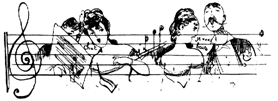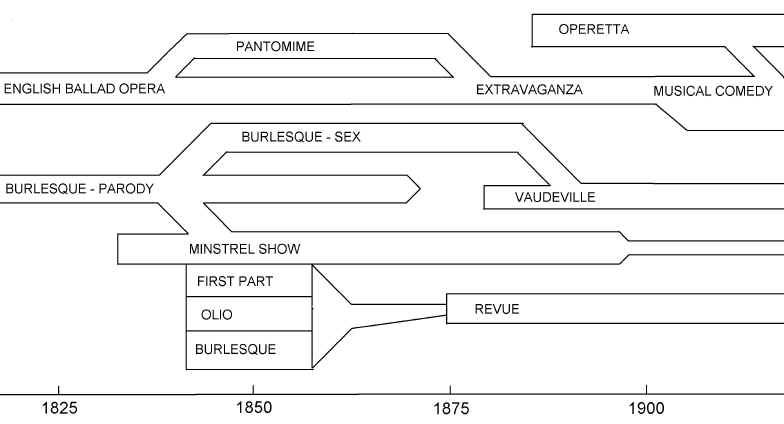
Dominic Vautier 1/7/2011
The term Musical Comedy is often referred to as that part of Broadway that included singing. This soon became a distinctive and completely American type of musical theater that was able to integrate music and story into a smooth presentation. The first American musical production that faintly resembled this was The Black Crook, first performed in 1866. This play was a far cry from the musical theater that developed 35 years later around the turn of the 20th century, but it was a beginning.

There were different kinds of early theater which often included music.
The English Ballad Opera was an early form of storytelling and singing imported directly from England and performed in the Colonies. Flora, the first such performance, was given in a courtroom in Charleston in 1735. The Ballad Opera had a small cast and musical accompaniment, but eventually got bigger and developed into the Extravaganza and the Pantomime.
The Extravaganza was not always or necessarily extravagant but it did involve large casts and sets. It became very popular just after the Civil War. This form of stage play eventually evolved into the musical comedy. The extravaganza had words, music, and a story, although loosely related. The plot was designed first, and music was added as an embellishment or afterthought. Not too much effort was made to connect plot and music, but it was all grand and fun spectacle.
The Pantomime enjoyed some popularity during and soon after the Civil War. It had spoken words, singing, dancing, and a predetermined set of characters. It derived its name from the exaggerated use of hand gestures.
The chart below shows the development of the American Musical Comedy along with other types of theater.

The English Operetta arrived in 1879 from England, and there were many American spin-offs of this English type of theater, all of which had little effect on popular music. America never fully accepted Operetta because of its difficult and often convoluted plot structure, not to mention its fast-paced, distinctly English music.
The Musical Comedy is a type of stage performance placed usually in an American setting, dealing with American social problems, and having a tightly woven relationship between music and story. The first true musical comedy was said to be George M. Cohanís Little Johnny Jones, although others claim that Babes in Toyland was the first. In any case, by the first few years of the 20th century the American Musical Comedy had established itself as a viable and popular form of American theater. It was to reach its perfection in 1947 with South Pacific, and has now evolved into what some refer to as a musical play.
While the extravaganza and the musical comedy were evolving, so was Burlesque, which had been around before 1800. Burlesque split three ways, into burlesque-parody, burlesque-sex, and burlesque-minstrelsy. Burlesque-sex was absorbed into vaudeville, while most burlesque-parody became a part of minstrelsy.
Popular music has always used Broadway to some extent as a source of material, but not so much in the early years. Some Broadway Songs became hits even before the musical comedy was fully developed. In the 1900 import from London Pulchritude, a completely unknown play by the way, the ensemble song Tell Me Pretty Maiden, totally captured the interest of New Yorkers. In fact a common come-on line for men became "Tell me pretty maid, are there any more at home like you?" This song transfer still happens today, but during the years when popular music was just getting established (1892 through 1915 in particular), borrowing from Broadway was at a much higher level. Many of the writers of that time moved freely between Broadway and vaudeville genres so it was natural that these shared much of their material. The very physical closeness of the two forms of music also tended to encourage a lot of sharing. Music written for Broadway that turned out to be successful was automatically published as popular music pieces. Popular music, while generating its own material, borrowed heavily from anywhere it could, and Broadway was, at that time, a very attractive source.
Here are some other links in this article:
Origins of Early Popular Music
Minstrelsy
Broadway
Vaudeville
Other sources